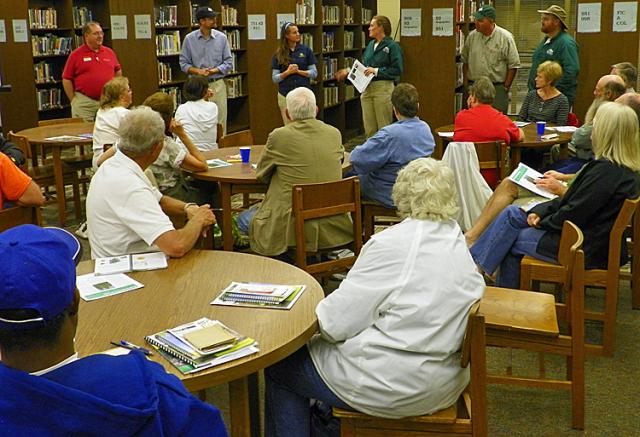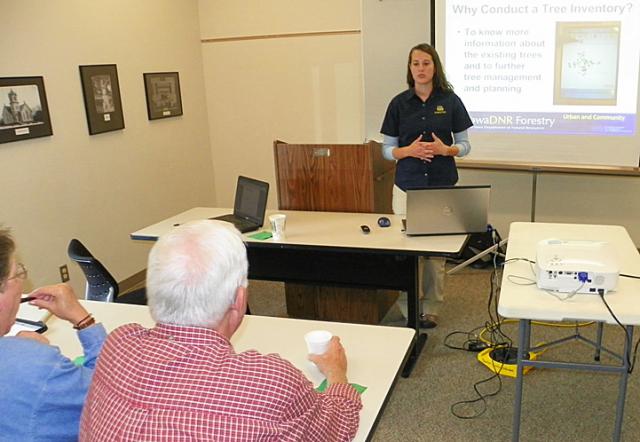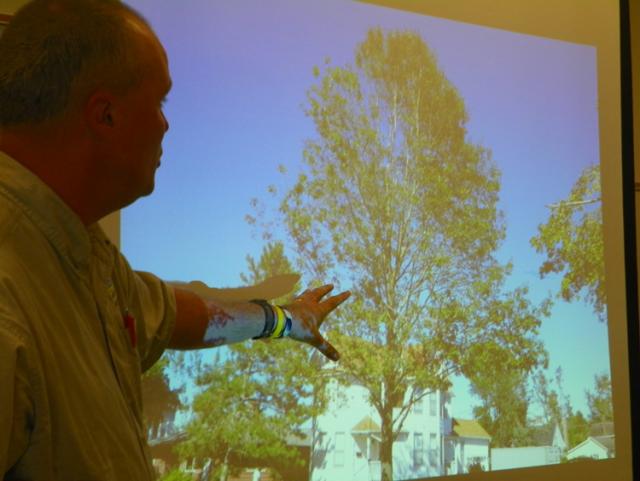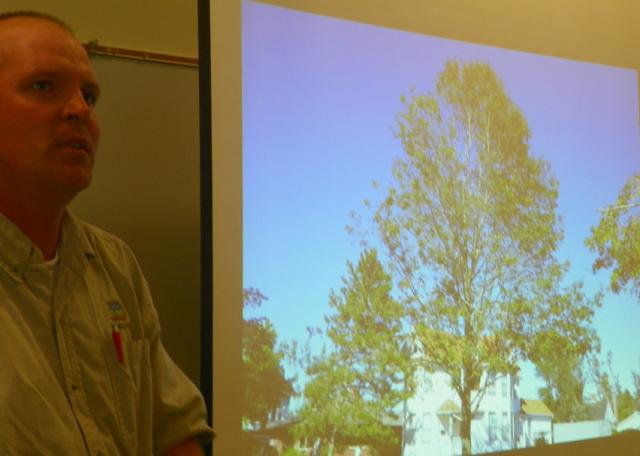The first of two meetings about the future of trees in Vinton and other area storm-damaged cities ended with an encouraging comment from a resident of Parkersburg.
"I was driving through Parkersburg yesterday," said Valerie Thorn, whose family survived the 2008 tornado with only damage to their roof from a flying tree limb.
"I saw that the trees we planted after the tornado are not just sticks. Our trees are starting to show up," said Thorn. "It was a very optimistic, hopeful thing for me -- it's starting to look like it's not so bare."
Thorn, the co-chair of Replant Parkersburg, spoke to local leaders at a meeting in Dysart attended by Vinton and Benton County leaders concerned about trees on public property. The Iowa DNR and ISU Extension service teamed up with Trees Forever on the meeting in Dysart. That meeting was followed by a public gathering Tuesday evening at the Vinton-Shellsburg High School. At that meeting, property owners received information about how they could deal with damaged trees and also learn about the best way to plant trees to replace those destroyed in the July 11 storm.
Nearly 100 people from Vinton and other area cities affected by the storm attended the two meetings.
"They are seeing an amazing recovery in Parkersburg," said DNR Urban Forester Emma Bruemmer. "And I know it will happen here."
Like Vinton residents, Dysart citizens can look up in the sky and see emptiness where once large trees filled the skyline. Their city, too, still is home to many large, uncut stumps, and buildings with tarps still covering roofs waiting to be repaired.
Mark Pingenot of Vinton, a Trees Forever field coordinator, and Greg Walston of the Benton County ISU Extension Service, organized the meetings.
In addition to Bruemmer, the presenters included DNR District Forester Mark Vitosh, tree specialist Jesse Randall of the ISU Extension Service and Meredith Borchardt of Trees Forever, who told the audience about funding opportunities available to government entities and non-profit organizations. The Dysart Tree Board hosted the event at the local library.
Those four also spoke during the meeting at Vinton Tuesday night, sharing some of the same information, but applying it specifically to property owners and their affected trees.
Randall, the ISU Extension forester, reminded city leaders what their first priority was after the storm: Safety. He described the necessity of removing limbs or trees that could fall, causing damage to property or danger to people.
One of the challenges that local leaders face, said Randall, is the fact that some people are not ready to acknowledge that the best thing for their damaged tree is to remove it. In some cases, he said, a tree can be trimmed and allowed to stay, as long as it does not pose a hazard. Usually, he said, most owners will eventually realize that they need to cut down the tree. Yet, he adds, a time of grieving and trying to save a tree, even one significantly damaged by the storm, is natural.
There are several guidelines that can determine when a tree can be saved, and when it should be removed, said Vitosh:
- Does the damaged tree present a hazard? If so, he said, nothing else matters other than removing the hazard. Sometimes a tree that may fall in an empty lot can be spared for a while, while a tree over a sidewalk or other place where people may be will need to come down sooner.
- The species of the tree makes a difference. An oak has a better chance of storm recovery than a soft wood tree like a silver maple.
- What percentage of the live crown remains? Trees can survive with as little as 30 to 50 percent of the crown, intact, depending on species, said Vitosh. But, he adds, any tree with less than 50 percent loss may have significant long-term problems.
- Tree size: The smaller a tree, the more likely it is to recover.
Tree inventory
Bruemmer told the group that an essential first step for any entity is a tree inventory. A complete inventory will document how many trees of what species are in a city, as well as the size, age and condition of those trees. She said that some computer programs can help cities keep track of each tree via computer. However, smaller towns usually do not have the resources for such detailed inventories.
Bruemmer gave the "Top 10" reasons for a tree inventory.
top ten reasons for inventory
10: Tree benefit calculation -- the benefits of doing an inventory always outweigh the costs;
9. Public outreach and education – thinking of trees as a public asset. Citizens need to understand how this helps a community;
8. Budgeting maintenance and planting costs over time;
7. Cost to benefit ratio: This justifies the budget;
6. Documentation and defense against litigation; and continuing right-of-way planting;
5. Increased efficiency;
4. Determines short term and long term goals;
3. It creates a reactive system that plans ahead, instead of a proactive system that responds only when there is a crisis;
2. Determines the direction of forestry program;
1. Maintain a healthy, stable and productive urban forest.
In his presentation about how to repair trees, Randall gave the audience several basic warnings:
1. Trees and their parts are very heavy
2. Tree work is very dangerous (and usually very high above the ground).
3. Leave it to the experts: Those who are bonded, insured and reputable.
4. If a tree has failed once, it will probably fail again. The only question is when. That, said Randall, is often hard to guess, even for the most knowledgeable experts.
Despite the challenges the presenters faced, Borchardt told the crowd that there are many people who are willing to help fund tree planting projects. She gave the city leaders information about a variety of state and utility grant programs.
Information for homeowners
The Vinton meeting Tuesday evening also included offering a variety of printed information, and time for residents to ask specific questions about their tree issues.
Vinton City Coordinator Andy Lent also told the audience that the city is in the process of creating a simple permit system to ensure that the trees planted on the city-owned areas meet the city tree ordinance guidelines.




Comments
Submit a CommentPlease refresh the page to leave Comment.
Still seeing this message? Press Ctrl + F5 to do a "Hard Refresh".